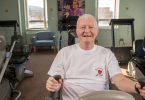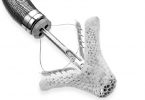Whether it’s after a particularly spicy meal or a few too many salty snacks during a sporting event, many people have “heartburn.” While it’s a common occurrence, you may not realize recurring feelings of heartburn can be a symptom of something more serious—heart disease. This is what happened to Dale Smith, a 64-year-old resident of Lisle, New York.
Late last year, Mr. Smith experienced a couple months of continually feeling ill, but he attributed it to heartburn and anxiety. By the first of the year, at the urging of his wife, he decided to ring in the New Year by visiting the hospital.
“On New Year’s Eve—my 43rd wedding anniversary—my wife told me, ‘You’re going to the emergency room,’” he says.
While at the Emergency Department, Mr. Smith experienced what he calls “one of his episodes” that he assumed was heartburn. After several tests—including a CT scan from his abdomen to his chest—it was discovered that Mr. Smith had an aneurysm in his aortic root, the section of the aorta that is attached to the heart. Since an aortic aneurysm widens the aorta and can lead to rupture and life-threatening bleeding, Mr. Smith was admitted to UHS Wilson Medical Center and scheduled for surgery.
Signs of Heart Valve Disease
Valve disease, with or without an aneurysm, can sneak up on you. Being aware of risk factors and symptoms will help you recognize it before it damages your body. If you have any of the following risk factors or symptoms, consider talking to your doctor about valve disease (or other heart conditions):
Risk Factors
- Hypertension or history of high blood pressure
- History of heart murmur
- Family history of heart disease
Symptoms
- Shortness of breath
- Heart murmur (as diagnosed by your physician)
- Chest pain and pressure
- Swelling in your legs
- Fainting, dizziness or lightheadedness
Addressing the aneurysm
An aneurysm like Mr. Smith was diagnosed with is a common aortic condition, especially in people with hypertension or high blood pressure. The aorta is the large artery that originates from the heart and carries blood from the heart to the rest of the body. Conditions that affect the aorta can also affect one or more of the heart’s four valves. When these types of valve conditions happen, the rest of the body may not receive adequate blood flow, leading to serious complications.
Daniel Beckles, MD, UHS cardiothoracic surgeon, explains that common valve conditions include valvular stenosis, which occurs when valve tissue stiffens; the narrowing of a valve; and valvular insufficiency, which is also known as “leaky valve” and occurs when a valve can’t close completely. Aneurysms, like the one Mr. Smith had, happen when an artery weakens and begins to bulge.
The UHS Heart & Vascular Institute treats these aortic and valve conditions using the latest surgical techniques to repair or replace compromised valves. They also focus on minimally invasive approaches, which cause less pain and fewer complications, and help patients recover faster. These approaches also contribute to a high level of effectiveness across the different procedures performed. When Mr. Smith was brought to UHS for open heart surgery, surgeons created a graft, which implanted a new aortic valve into his heart, using a technique called the Bentall procedure. This repaired his diseased aortic root.
Other procedures performed at the UHS Heart & Vascular Institute include transcatheter aortic valve replacement (TAVR). This minimally invasive procedure allows a new valve to be inserted into a patient without the damaged one being removed.
Minimizing recovery
The UHS Heart & Vascular Institute offers all of these techniques as minimally invasive procedures and has also expanded to include treatment for patients with conditions affecting any of the four heart valves, not just the aortic valve.
“We offer personalized care for all patients and use minimally invasive surgery when it makes the most sense for the patient,” says Dr. Beckles. “Even open heart surgery can be done in a minimally invasive fashion, never splitting the sternum.”
This is important, because minimally invasive surgery allows for less bleeding and scarring and a faster recovery time than traditional surgery, where surgeons cut through the sternum, or breast bone.
Mr. Smith’s surgery was considered open heart surgery, and after a brief recovery period in the Cardiac Care Unit, he says he was feeling healthier than he had in several years and was able to return to his work as a service manager at a local tractor dealership. “I got the best care I could have asked for,” he says. “I was very happy with everybody who was there. I took some veggies and fruits to the doctors and nurses as a thank you for the phenomenal care.”
HEART TO HEART
Cardiovascular disease accounts for about 1 in 4 deaths in America. To learn more about how UHS can help you fight heart disease, visit nyuhs.org or call 763-6580.







